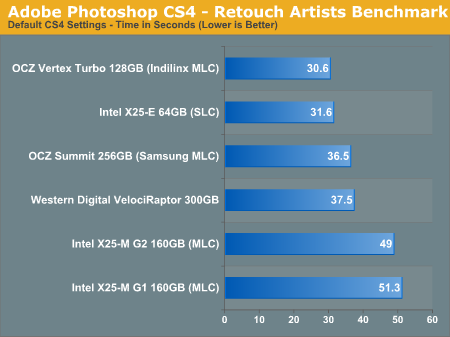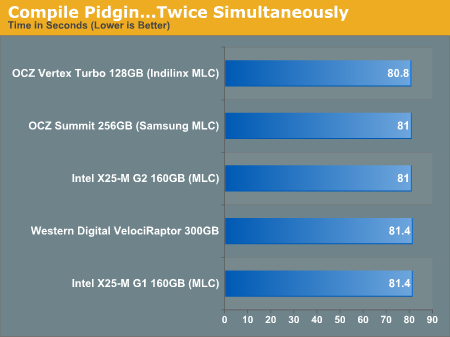The SSD Relapse: Understanding and Choosing the Best SSD
by Anand Lal Shimpi on August 30, 2009 12:00 AM EST- Posted in
- Storage
Individual Application Performance
PCMark Vantage does a great job of summarizing system performance, but I thought I'd pick a couple of applications to showcase real world strengths/weaknesses of these drives.
The first test is our Photoshop CS4 benchmark by the Retouch Artists. I made one small change to the way this test is run however. Normally I set the number of history states in Photoshop to 1, this significantly reduces the impact of the HDD/SSD on the test and makes it a better measure of CPU/memory speed. Since this is an SSD article, I've left the setting at its default value of 20. The numbers are now a lot lower and the performance a lot more disk bound.

I didn't run all of the drives through this test, just one from each major controller. The results speak for themselves. The Indilinx drives are actually the fastest MLC drives here. Even the Samsung is faster than the Intel drives in this test. Why? Sequential write speed. Even the VelociRaptor has a higher sequential write speed than the X25-M. So while sequential write speed isn't the most important metric to look at when evaluating an SSD, there are real world situations where it does matter.
Intel's performance here is just embarassing. Sequential write speed is something Intel needs to take more seriously in the future. Throw in any amount of random read/write operations alongside your Photoshop usage and the Intel drives would redeem themselves, but this is a very realistic snapshot of their achilles' heel.
Many of you have been asking for compiler benchmarks so I did just that. I grabbed the latest source for Pidgin (a popular IM application) and followed the developer's instructions on building it in Windows:

Nada. I thought perhaps it wasn't stressful enough so I tried building two instances in parallel:

And...nothing. It seems that building Pidgin is more CPU than IO bound, or at least its IO access isn't random enough to really benefit from an SSD. I'll keep experimenting with other compiler tests but this one appears to be a bust for SSD/HDD performance testing.










295 Comments
View All Comments
Anand Lal Shimpi - Monday, August 31, 2009 - link
Maybe I should compile these things into a book? :)Here are my answers about some stuff:
1) There's a spec for how hard drive makers report capacity. They define 1GB as 1 billion bytes. This is technically correct (base 10 SI prefix as you correctly pointed out). The HDDs also physically have this much storage on them, they are made up of sequentially numbered sectors that are easily counted in a decimal number system.
All other aspects of PC storage (e.g. cache, DRAM, NAND flash) however work in base 2 (like the rest of the PC). In these respects 1GB is defined as 1024^3 because we're dealing with a base 2 number system. There are reasons for this but it goes beyond the scope of what I'm posting :)
Intel adheres to the same spec that the HDD makers use. But the X25-M is made up of flash, which as I just mentioned is addressed in a base 2 number system. There's more flash than user space on the drive, it's used as spare area, woohoo. I think we're both on the same page here, just saying things differently :)
2) We'll see a 320GB drive, just not this year. I don't know that the demand is there especially given the weak economy.
Dreams do sometimes come true... ;)
3) Perhaps, but I don't like the idea of a drive doing anything but idling when it's supposed to be...idle. This does funny things to notebook battery life I'd think.
4) This is true. There's also another thing you can do with the jumper (and perhaps some additional software): flash any indilinx drive with any firmware regardless of vendor :)
5) I had to throw out a lot of data because of variations between runs. It ended up being a combination of immature drivers, immature benchmarks and some OS trickery. The setup I have now is very reliable and provides very repeatable results with very little variation. While I run everything three times, the runs are so close that you could technically do only one run per drive and still be fine.
6) I wouldn't count WD and Seagate out just yet. It may take them a while but they won't go quietly...
7) Samsung makes a ton of money from SSD sales to OEMs, they don't seem to care about the end user market as much. If end users start protesting Samsung drives however, things will change.
In my opinion? Once Apple falls, the rest will follow. If Apple will migrate to Intel (possible) or Indilinx (less likely), we'll see the same from the other OEMs and Samsung will be forced to change.
Or I could be too pessimistic and we'll see better performance from Samsung before then.
8) Agreed :)
I'll finish here too :)
Take care,
Anand
Reven - Monday, August 31, 2009 - link
Anand, dont listen to the guys like blyndy who diss on the anthologies, I love them. You can find a basic review anywhere, its the in-depth yet simple to understand stuff like these anthologies that make me visit Anandtech all the time.Keep it up, dude!
Anand Lal Shimpi - Monday, August 31, 2009 - link
Thank you :)EasterEEL - Monday, August 31, 2009 - link
I have a couple of questions regarding the Intel® SATA SSD Firmware Update Tool (2832KB) v1.3 8/24/2009.Does this firmware enable TRIM within the SSD to work with Windows 7?
If AHCI is enabled in the BIOS (but not RAID) does Windows 7 use it's own drivers with TRIM? Or does it load Intel’s Matrix Storage Manager driver which does not support TRIM as per the article note below?
"Unfortunately if you’re running an Intel controller in RAID mode (whether non-member RAID or not), Windows 7 loads Intel’s Matrix Storage Manager driver, which presently does not pass the TRIM command. Intel is working on a solution to this and I'd expect that it'll get fixed after the release of Intel's 34nm TRIM firmware in Q4 of this year."
Anand Lal Shimpi - Monday, August 31, 2009 - link
That update does not enable TRIM. The TRIM firmware is in testing now and it will be out sometime in Q4 of this year (October - December).If AHCI is enabled in the BIOS and you haven't loaded Intel's MSM drivers then it will use the Windows 7 driver and TRIM will be supported.
Take care,
Anand
uberowo - Monday, August 31, 2009 - link
I do have a question however. :DI am building a gaming pc, and I am buying ssd disk/s. Would I benefit from getting 2x80gb intel gen2s and using raid0? Or should I stick with a single 160gb?
Anand Lal Shimpi - Monday, August 31, 2009 - link
While I haven't tested 2 x 80GB drives in RAID-0, my feeling is that a single SSD is going to be better than two in RAID going forward. As of now I don't know that anyone's TRIM firmware is going to work if you've got two drives in RAID-0.The perceived performance gains in RAID-0 also aren't that great on SSDs from what I've seen.
Take care,
Anand
Ardax - Monday, August 31, 2009 - link
A naive guess would be that it depends on the workload. For lots of sequential transfers a RAID-0 should shine -- particularly on reads -- because you're spreading the transfers out over multiple SATA channels.Losing TRIM is a problem. Finding a controller than can handle the performance is entirely likely to be another.
uberowo - Monday, August 31, 2009 - link
Thanks a lot for taking the time to answer. Not to mention making this awesome site. :)Anand Lal Shimpi - Monday, August 31, 2009 - link
You guys take the time to read it and make some truly wonderful comments, it's the least I can do :)-A